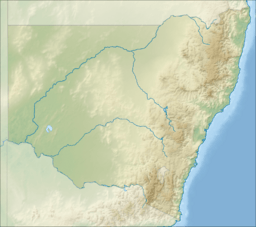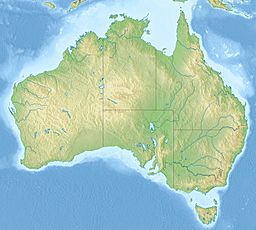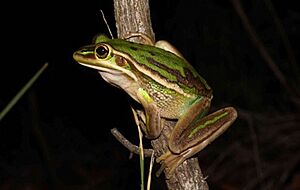Wamberal Lagoon facts for kids
Quick facts for kids Wamberal Lagoon |
|
|---|---|
 |
|
| Location | Central Coast, New South Wales, Australia |
| Coordinates | 33°26′S 151°27′E / 33.433°S 151.450°E |
| Type | Intermittently closed intermediate saline coastal lagoon |
| Primary inflows | Forresters Creek |
| Primary outflows | Tasman Sea of the South Pacific Ocean |
| Catchment area | 5.8 square kilometres (2.2 sq mi) |
| Basin countries | Australia |
| Surface area | 50 hectares (120 acres) |
| Average depth | 1.7 metres (5 ft 7 in) (AHD) |
| Water volume | 880.2 megalitres (31.08×106 cu ft) |
| Surface elevation | 0 m (0 ft) |
| Settlements | Forresters Beach, Wamberal |
Wamberal Lagoon is a special kind of water body called a coastal lagoon. It's found on the Central Coast of New South Wales, Australia. This lagoon is located right between the beach towns of Forresters Beach and Wamberal. It's about 87 kilometers (54 miles) north of Sydney.
What is Wamberal Lagoon?
Wamberal Lagoon is a coastal lagoon, which means it's a shallow body of water near the sea. It's also "intermittently closed," meaning it sometimes opens up to the ocean and sometimes gets blocked off. The water in the lagoon is salty, like the ocean.
How Big is the Lagoon?
The lagoon gets its water from stormwater runoff that flows into Forresters Creek. When it's full, Wamberal Lagoon covers an area of about 50 hectares (124 acres). The land area that drains into the lagoon, called its catchment, is about 5.8 square kilometers (2.2 square miles).
Lagoon's Connection to the Ocean
The lagoon usually flows into the Tasman Sea, which is part of the South Pacific Ocean. However, this connection is often closed off by sand. This means the water levels inside the lagoon are not usually affected by the ocean's tides.
Wamberal Lagoon Nature Reserve
The lagoon and the land around it, covering 139 hectares (343 acres), are part of the Wamberal Lagoon Nature Reserve. This special area was created in 1981 to protect the environment. It is managed by the NSW National Parks & Wildlife Service. Other lagoons nearby include Terrigal Lagoon and Avoca Lake.
Protecting Wamberal Lagoon
The Wamberal Lagoon Conservation Society (WLCS) was started in 1983. This group works to protect the lagoon and its surrounding areas. They want to keep it safe from too much building and development.
Why is Conservation Important?
The WLCS follows rules from the National Parks and Wildlife Act. These rules say that nature reserves are for:
- Taking care of and protecting wildlife.
- Looking after natural environments and amazing natural things.
- Studying wildlife and nature.
- Helping people enjoy and appreciate wildlife and nature.
What the Society Does
To achieve these goals, the WLCS does many things. They teach people about the lagoon and work with other groups who care about nature. They also talk to authorities who make decisions about the nature reserve.
Members of the WLCS often take part in "bushcare" activities. This means they remove rubbish and harmful invasive plants from sensitive areas. They also plant native plants to help the environment.
Bringing Back the Green and Golden Bellfrog
In 2018 and 2019, the WLCS started a project to improve the lagoon's habitat. Their main goal was to make the water cleaner. This would help bring back an endangered frog species called the Green and Golden Bellfrog (Litoria aurea).
This frog used to be common in the area but has mostly disappeared. The WLCS is working with the NSW National Parks and Wildlife Service and the Central Coast Council. They are finding ways to reduce pollution, for example, by using special traps called Gross Pollutant Traps in waterways. They also replace invasive weeds with native plants to help local animals and plants thrive.
Amazing Wildlife at Wamberal Lagoon
The WLCS has put together a list of animals found within one kilometer of the lagoon. This list shows how many different kinds of plants and animals live there, making it a very important place to protect. Here are some examples of the amazing wildlife you might find:
Amphibians
You can find different types of frogs around the lagoon, including:
- Bleating Tree Frog
- Eastern Dwarf Tree Frog
- Peron's Tree Frog
- Striped Marsh Frog
Birds
Many birds call Wamberal Lagoon home or visit it. Some common ones include:
- Kookaburra
- Australian Magpie
- Sulphur-Crested Cockatoo
- Galah
- Australian Pelican
- Black Swan
- White-bellied Sea Eagle
Fish
The lagoon's waters are home to various fish species, such as:
- Short-finned Eel
- Eastern Australian Salmon
- Dusky Flathead
- Yellowfin Bream
Mammals
You might spot some mammals near the lagoon, including:
- Swamp Wallaby
- Australian Brushtail Possum
- Grey-Headed Flying-Fox
- Short-Beaked Echidna
Reptiles
Several reptiles also live in the area, like:
- Water Dragon
- Green Tree Snake
- Red-Bellied Black Snake
- Eastern Blue-Tongue
Images for kids





